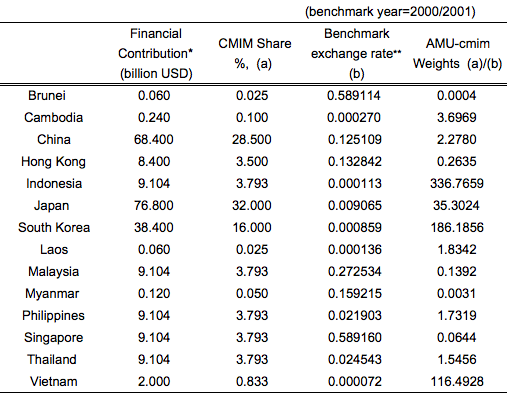Newly Organized Data of the Asian Monetary Unit Based on the Contribution Proportion of the CMIM (AMU-cmim)
The Asian Monetary Unit (AMU), which was created as a joint Global COE project between Hitotsubashi University and the Research Institute of Economy, Trade and Industry (RIETI), is a common currency basket composed of 13 East Asian currencies, including the ASEAN 10 plus Japan, China, and South Korea. The basket weight of the AMU is calculated with the arithmetic average share of intra-regional trade volume and gross domestic product (GDP) measured at purchasing power parity (PPP), according to the method used to calculate the European Currency Unit (ECU) adopted by EU countries under the European Monetary System (EMS). The methodology to calculate the basket weight is controversial and has been discussed many times so far.
Following the agreement on the Chiang Mai Initiative Multilateralization (CMIM) on May 3, 2009 in Bali, Indonesia, an Asian Monetary Unit based on CMIM contribution share (AMU-cmim) was created. The characteristics of the AMU-cmim are as follows:
- The basket share of AMU-cmim is based on the individual country's contribution proportion of CMIM (the total size of the CMIM is $ 240 billion).
- The Hong Kong dollar participates in the composition currencies of AMU-cmim.
Please note that the AMU-cmim basket currency weights are calculated based on the value of CMIM contributions by each country, which were adjusted at the 15th ASEAN+3 Finance Ministers and Central Bank’s Governors’ meeting held in Manila, Philippines on May 3, 2012.
The AMU-cmim basket currency weights are as follows:

We can use the AMU-cmim weights in above table to calculate an exchange rate for the AMU-cmim in terms of the US$-euro as follows:

The AMU and AMU Deviation Indicators have been proposed as one of the surveillance indicators for coordinated exchange rate policies under the CMIM, which was established in May, 2005 by the ASEAN plus 3 as a network of bilateral and multilateral swap arrangements to prevent a currency crisis in the future. The AMU-cmim and AMU-cmim Deviation Indicators will be expected to play an important role as new surveillance indicators corresponding to the new agreement of the CMIM. The calculations of the AMU-cmim and AMU-cmim Indicators are the same as those of the AMU, however, the basket weights of the AMU-cmim are not revised annually. The benchmark period, which fixes the benchmark exchange rates, is decided by the average of daily exchange rates between 2000 and 2001 in the same way as the AMU.

